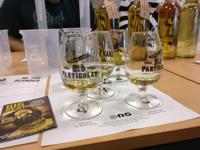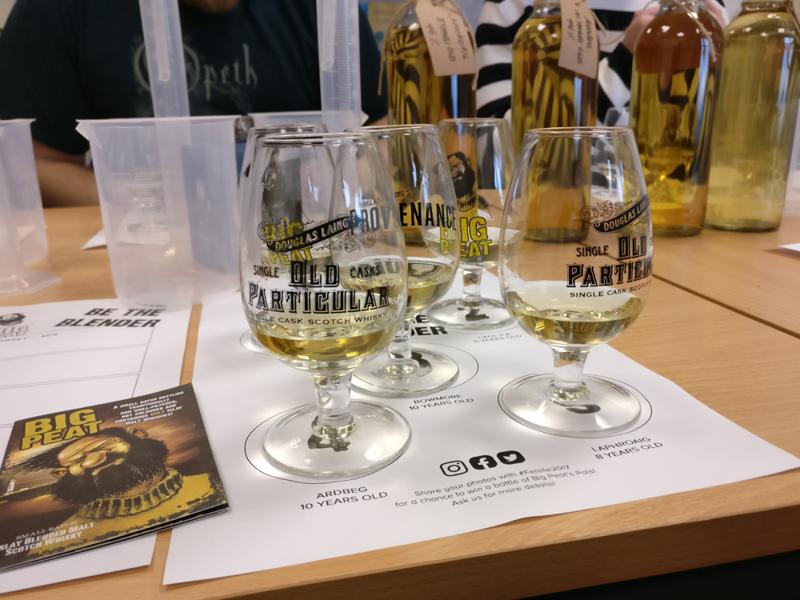TLDR
Whisky Glassware
One of the very first questions any whisky drinker asks is about the right glassware. Sadly the answer is a little more complex. It does not exist. Phrased more diplomatically it depends on the drink, and more importantly the drinker. Just as there is no such thing as The best whisky, there is no single perfect glass for its tasting.The Long Read
Contents
- What Are The Best Whisky Glasses?
- Historical Background
- Whisky Enjoyment
- The Tulip Shaped Copita
- The Glencairn Glass
- Scotch Malt Whisky Society Tasting Glass
- The Blender’s Glass
- The Cognac Glass
- The NEAT Glass
- The Norlan Whisky Glass
- The Túath Glass
- Whisky glasses with lids
- The Tumbler
- The Highball Glass
- What is the Best Whisky Glass

What Are The Best Whisky Glasses?
- The SMWS glass - the best all rounder
- The Glencairn - the most widely known glass, poorer for grain whiskies
- The Copita - fantastic for grain and sherried whiskies
- The Cognac Glass - widely available and great for most drams, weaker on peat
- The Blender’s Glass - perfect for blended whisky, good for grain
- The Túath Glass - solid for bourbons, ryes and Irish pot still
- The NEAT Glass - the perfect upgrade from a tumbler, excellent for high ABV
- The Norlan - an expensive tumbler
- The Tumbler - for those who want their whisky chilled
- The Highball - for those looking for refreshment

Historical Background
If you look into the history of whisky drinking, you will quickly come across the “Quaich” or “Quaigh” or “Quoich”. All three words come from the Gaelic term for “cup”, “Cuach” and denote a kind of flat drinking bowl with two handles on the right and left. Early forms were made from wood, later from stone, horn and then from silver and / or glass. The latter are often richly decorated or engraved. The Quaich probably originated in the Highlands, where it was served in the large cities of Edinburgh and Glasgow in the late 17th century, mainly for the enjoyment of whisky, and in “better society” for brandy. So, according to history, Sir Walter Scott served his dramas in silver quaichs. Today the Quaich is sometimes still used as a trophy, especially at traditional events such as Highland Games,
Whisky Enjoyment
Nowadays only glasses are used to enjoy whisky, but that actually ends the agreement on a “standard”. A whole series of very different shapes of whisky glasses have developed over time, each shape has its lovers, each one its advantages and disadvantages and each glass is always to be seen in direct connection with the whisky to be tasted.
The Tulip Shaped Copita
Also called the nosing glass or ‘Dock Glass’ the Copita-Style glass was created for tasting sherry in Spain. Once named the ‘dock’ glass on account of its use by merchants who used it to nose wines and spirits at docksides.
This glass shape is characterized by its high stem on and bulbous bowl, which tapers towards the top in the shape of a tulip and has a narrow, outwardly curved drinking rim. The long handle keeps the hand with all its possible smells away from the opening of the glass. The wide belly offers enough space for the whisky and thus the air it needs to slowly unfold in its fullness. The tapered neck focuses the aromas that are released in the glass channelling them towards the nose. As an added benefit it nestles comfortably in the hand if you want to warm up the whisky by cupping the base of the bowl.
The shape of the glass tapers towards the top. The lower part of the glass is wider and gives the liquid room to breathe and develop its aroma. The perfect glass for tasting whisky or enjoying single malt is therefore a sturdy stemmed glass, preferably with a logo from a well-known whisky manufacturer.
The Glencairn Glass
Despite its short history, the Glencairn glass is usually the first choice for whisky connoisseurs. The Glencairn glass shape is very similar to that of the tulip-shaped nosing glass. The big difference to this, however, is the compact base of the “Glencairn”, which has replaced the long stem of the nosing glass. It makes this “Glencairn” glass more robust, and thus a glass that can often be found in distilleries or at trade fairs for tastings.
The wide belly offers the whisky enough space and thus the air it needs to slowly unfold in its fullness. The chimney-like rejuvenation focuses the aromas that are released in the middle of the glass and lets them glide out of the glass in a concentrated manner over the outwardly curved drinking rim. The “Glencairn” glass also nestles comfortably in the hand, if you want to warm up the whisky lying in the glass a little, supported by the delicate glass walls.
It is the first glass that was made exclusively for the enjoyment of whisky and was almost forgotten in the drawer of its inventor. But things turned out differently and in 2001 the Glencairn glass celebrated its premiere as a whisky glass
Scotch Malt Whisky Society Tasting Glass
The Scottish Malt Whisky Society (SMWS) glass is a great allrounder. While Michael Jackson identified what he called ‘unhappy aromas’ in his glass and I am loath to disagree with Mike the SMWS glass has become the defacto ‘show’ tasting glass for my whisky group*. It has a tendency to make whiskies a little drier and the narrower nose builds and concentrates alcohol in a way that requires caution. Despite this the glass has earned the best overall score across numerous tastings, it dazzles for sherry, is phenomenal for grain and older blends, it scores slightly lower on peated drams but only marginally compared to the Glencairn. *When we attend whisky shows we generally take a couple of glasses so as to enjoy grain, peated and unpeated malts from different glasses and to let drams sit.
The Blender’s Glass
A modern replica of the Art Deco style of glass used by blenders in the 1920s. The tulip shape helps to concentrate the flavours, resulting in a more intense sensory experience. Fantastic for older blends but unfortunately a glass which amplifies the faults in a whisky. This is a glass for those who shop at auction sites rather than the everyday drinker.
The Cognac Glass
Also known as the Brandy Bowl, this glass would look at home in a dark panelled Gentlemen’s Club. Originally created for tasting cognac and other brandies, this glass is now used for tasting almost all dark, old alcoholic beverages in general. The shape is usually designed in such a way that the alcohol cannot leak out even if you hold the snifter horizontally. However, some aromas will quickly be lost through the short neck with its wide opening.
The NEAT Glass
The Naturally Engineered Aroma Technology (NEAT) glass resulted from faulty production. Created by George Manska in error during a glass blowing session, instead of discarding the glass he put it on the shelf. After picking it up one day at random he was amazed to discover that it possessed new and unusual properties. Its wide belly invited swirling, the evaporation was intensified and the lighter alcohols quickly escaped through open neck. This created more space for the heavier substances that spread out emphasising their aromas. Thus paving the way for the enjoyment of even higher ABV whiskies.
The Norlan Whisky Glass
Marketed as “The Glass that will change Whisky” the glass began as a Kickstarter project in 2015. With the help of Jim McEwan, (at the time) Master Distiller of the renowned Bruichladdich distillery, the glass was developed using ongoing experimentation and a 3D printer. Ultimately while the shape of the glass resembles that of a tumbler it’s designed to act and nose more like a nosing glass. Alas the double wall system with vacuum in between prevents warming the liquid. It’s also priced to attract the attentions of one time buyers. A fantastic drinking experience compared to a tumbler but sadly the glass is little more than an expensive dust catcher in the nosing world.
The Túath Glass
The TÚATH (tu - ah) from the old Irish for a tribe or clan (and also the origin of the word Fenian), is a conical shaped nosing and tasting glass for whisky that functions superbly by concentrating & capturing all the aromas and flavours that make Irish Whisky unique. Or so goes the marketing. Impractical terms while the conical shape of The Túath concentrates the vapour, and the bowl allows for a solid range of movement the glass scores in the lower echelons. Seemingly more an attempt to capitalise on the emerging Irish whisky market, the glass scores points for its squat less fragile stem, bulbous bowl but ultimately loses them for its absurd lip and awkward base. The base was designed to resemble the Irish island Skellig Michael (used for the shooting of two Star Wars films).
Whisky glasses with lids
Whisky glasses with lids offer a good opportunity to rediscover your whisky in a new or different way. The aromas in the glass cannot escape through the lid. Even better. They concentrate the aromas and thereby also bring out nuance that you have not smelled or noticed before. Usually you get the Glencairn or Nosing jar with a lid.
The Tumbler
Traditionally, the whisky glass was a crystal tumbler that was used for brandy with soda in the 1940s. Also known as Rocks Glass or Lowball the tumbler is a comparatively poor whisky glass. Despite what Hollywood might lead the casual drinker to believe these glasses are barely worthwhile as pure whisky glasses, though they have another audience. Especially popular among whisky drinkers who want to enjoy their drama on a piece of ice, or in the form of a wide variety of cocktails.
The Highball Glass
The big brother of the tumbler, the Highball glass holds 240 to 350 ml and is the standard glass for long drink classics such the Gin & Tonic, or Bloody Mary. While few in the west woul opt for a Scotch & Soda it makes a refreshing alternative to beer and is very popular in the east. Especially in Japan.
What is the Best Whisky Glass
The Society nosing glass is the highest scoring all around whisky glass, scoring above the traditional Glencairn and Copita in most categories. Grain whiskies come into their own
Regardless there is no right or wrong when using a whisky glass. There are a vast variety of whisky glasses, and the price point is humongous. Of course, this depends on the different properties. The type of glass, the material but also the brand can be important factors.
References:
The NEAT Glass Review The Glencairn Whisky Glass A touch of glass
Previous

